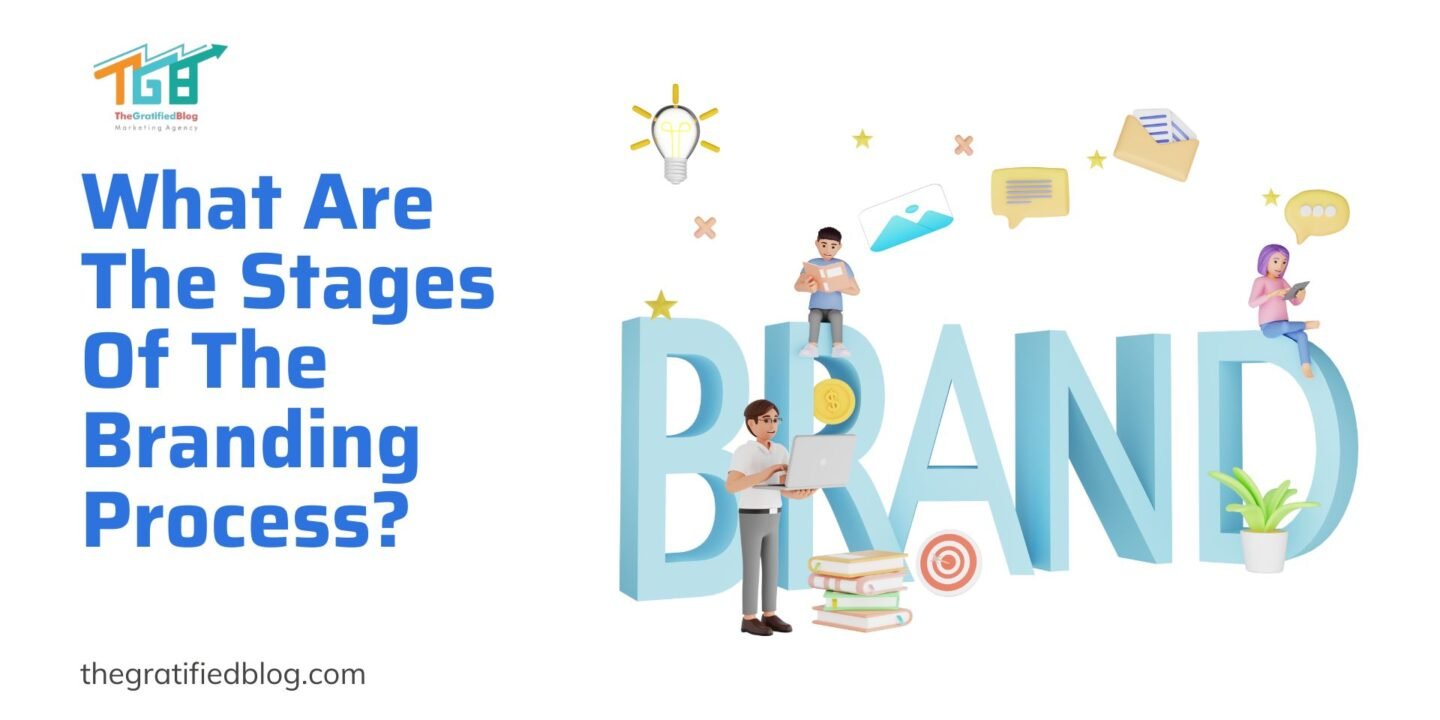
In today’s competitive market, branding has become essential to any business strategy, regardless of size or industry. It is no longer just about having a unique logo or a catchy slogan; it is about creating an identity that resonates with your target audience. Understanding the stages of branding is crucial for businesses looking to build a strong and lasting brand presence.
In this blog, “What are the stages of the branding process?” we will explore the process of branding and how it contributes to a brand’s overall success. Whether you’re a startup or an established company, grasping these stages can provide valuable insights and practical steps to elevate your brand to new heights.
What Is Branding?

Branding is the process of creating a strong, positive perception of a company, its products, or services in the customer’s mind by combining elements such as logo, design, mission statement, and a consistent theme throughout all marketing communications. A well-defined and executed brand marketing strategy affects all aspects of a business and is directly connected to consumer needs, emotions, and competitive environments.
Elements Of Branding
Here are the key elements of branding:
- Brand Identity: This includes the visual elements of the brand, such as the logo, color scheme, typography, and imagery. Create a brand identity that makes your business instantly recognizable to consumers.
- Brand Image: This is the perception of your brand in the market. It’s how customers view your brand based on their experiences and interactions with it.
- Brand Positioning: This refers to the space your brand occupies in the minds of consumers and how it differentiates from competitors. Effective positioning highlights the unique value and benefits your brand offers.
- Brand Personality: Like a person, a brand can have a personality characterized by human traits. Whether friendly, professional, innovative, or trustworthy, brand personality helps establish an emotional connection with the audience.
- Brand Voice and Tone: This involves how your brand communicates with its audience, including the language, style, and attitude conveyed through all forms of communication.
- Brand Promise: This is your commitment to your customers and what they can expect from your products or services. It’s a crucial part of building trust and loyalty.
What Are The Importance Of Branding?

Here are some key reasons why branding is critically important for any business:
- Differentiation: In a crowded marketplace, branding helps differentiate your business from competitors. A strong brand stands out and captures the attention of potential customers, making it easier for them to choose your product or service over others.
- Credibility and Trust: A consistent and professional brand image builds credibility and trust among consumers. Customers who recognize and trust your brand are more likely to purchase and remain loyal over time.
- Customer Loyalty: Effective branding creates an emotional connection with customers, fostering loyalty and repeat business. A strong brand not only attracts new customers but also retains existing ones.
- Market Value: A well-established brand adds value to your business. It can lead to better pricing power, increased customer loyalty, and a stronger market presence. Moreover, a strong brand is a valuable asset that can enhance your company’s financial performance.
- Consistency: Branding ensures consistency across all marketing platforms and communication channels. Consistent messaging and visual elements reinforce your brand identity and make it easier for customers to recognize and engage with your brand.
What Are The Stages Of The Branding Process?

Let us explore the key stages of the branding process and provide insights into how you can effectively navigate each one to achieve your branding goals.
Research And Analysis
Market Research
The first stage of the branding process is research and analysis. This involves gathering information about the market, competitors, and target audience. Market research is crucial for understanding the landscape in which your brand will operate. It helps identify trends, consumer behaviors, and gaps in the market that your brand can fill.
- Industry Research: Understand the current state of the industry, including key players, market size, growth trends, and regulatory factors.
- Competitor Research: Identify direct and indirect competitors and analyze their branding strategies, strengths, weaknesses, and market positioning.
- Customer Research: Understand your target audience’s demographics, psychographics, needs, and pain points. This can be done through surveys, focus groups, and social media listening.
Internal Analysis
Understanding your own business is equally important. Conduct an internal analysis to assess your company’s strengths, weaknesses, opportunities, and threats (SWOT analysis). This helps identify unique value propositions and core competencies that can be leveraged in branding.
- Mission and Vision: Clarify your company’s mission, vision, and values. These elements are foundational strategies to improve brand identity.
- Brand Audit: Evaluate your existing brand assets, including logos, taglines, and brand messages. Determine what’s working and what needs improvement.
Brand Strategy Development
Brand Positioning
Brand positioning is the branding process that defines how you want your brand to be perceived by your target audience. It involves creating a unique and compelling value proposition that differentiates your brand from competitors.
- Positioning Statement: Craft a concise statement that encapsulates your brand’s unique value and position in the market. This should address the target audience, the category, the benefit, and the proof of the benefit.
- Differentiation: Identify key differentiators that set your brand apart from competitors. These could be product features, customer service, pricing, or brand personality.
Brand Messaging
Brand messaging involves developing the core messages that communicate your brand’s value proposition, personality, and promise to the audience.
- Tagline and Slogan: Create a memorable tagline or slogan that succinctly conveys your brand’s essence.
- Key Messages: Develop key messages that communicate the most important aspects of your brand to different audiences. These messages should be consistent across all marketing channels.
Brand Identity Design
Visual Identity
The important stage brand strategy includes all the visual elements that represent it, such as the logo, color palette, typography, and imagery. These elements work together to create a cohesive and recognizable branding process design.
- Logo Design: Design a simple, memorable logo that reflects your brand’s personality and values. Consider different variations for different uses (e.g., full logo, icon, wordmark).
- Color Palette: Choose a color palette that aligns with your brand’s personality and evokes the desired emotional response from your audience. Different colors have different psychological effects and can influence perception.
- Typography: Select fonts complementing your brand’s visual style and ensuring readability across different media. Consistent use of typography helps in creating a cohesive brand image.
- Imagery and Graphics: Develop a style guide for imagery and graphics that reflects your brand’s tone and message. This includes photographs, illustrations, icons, and other visual elements.
Brand Voice and Tone
Your brand’s voice and tone define how it communicates with the audience. They should be consistent across all communication channels and reflect your brand’s personality.
- Voice: Establish a distinct voice that aligns with your brand’s personality. For example, a brand can have a friendly, professional, or authoritative voice.
- Tone: Define the tone of your communication based on the context and audience. The tone can vary but should always be consistent with the brand’s voice.
Brand Implementation
Brand Guidelines
Developing comprehensive brand guidelines is essential for ensuring consistency in brand implementation. These guidelines serve as a reference for everyone creating and communicating the brand.
- Visual Guidelines: Document the specifications for all visual elements, including logo usage, color codes, typography, and imagery. Provide examples of correct and incorrect usage.
- Messaging Guidelines: Outline the key messages, tagline, and voice and tone guidelines. Include examples of how to use these elements in different contexts.
- Application Guidelines: Provide instructions for applying the brand across various touchpoints, such as marketing materials, websites, social media, packaging, and signage.
Internal Branding
Internal branding ensures that employees understand and embody the brand. This is crucial for creating a consistent brand experience for customers.
- Employee Training: Conduct training sessions to educate employees about the brand, its values, and how they can represent it in their roles.
- Brand Culture: Foster a brand-centric culture by aligning internal practices and policies with the brand’s values. Encourage employees to live the brand in their daily interactions.
Brand Launch
The brand launch is a critical brand strategy stage during which your brand is introduced to the market. A successful launch requires careful planning and execution.
Pre-Launch Activities
- Teaser Campaigns: Generate excitement and anticipation through teaser campaigns on social media posts, email, and other channels.
- Stakeholder Engagement: Inform key stakeholders, including employees, partners, and investors, about the upcoming launch and how it will impact them.
Launch Strategy
- Launch Event: Plan a launch event to unveil your brand. This could be a physical event, a virtual event, or a combination of both.
- Marketing Campaigns: Implement a multichannel marketing campaign to promote the brand. Use a mix of online and offline channels to reach your target audience.
Post-Launch Activities
- Monitoring and Feedback: Monitor the brand’s performance and gather feedback from customers, employees, and other stakeholders. This helps identify issues and make necessary adjustments.
- Continuous Engagement: Keep the momentum by engaging with your audience through regular updates, promotions, and brand content.
How To Manage And Maintain Your Brand?

Managing and maintaining your brand is an ongoing process that requires constant attention and adaptation. Here are some essential steps to ensure your brand stays robust and relevant in the ever-changing market landscape:
- Brand Audits: Conduct regular brand audits to ensure consistency and identify areas for improvement. This includes reviewing brand assets, messaging, and customer orientation.
- Brand Refresh: Periodically update your brand elements to keep them fresh and relevant. Depending on the needs, this could involve minor tweaks or a complete rebranding.
- Customer Experience: Deliver exceptional customer experiences that align with your brand promise. This helps in building trust and loyalty.
- Engagement and Community Building: Engage with your audience through social media, events, and other platforms. Create a sense of community around your brand.
- Loyalty Programs: Implement loyalty programs to reward repeat customers and encourage word-of-mouth referrals.
How To Measure Brand Performance?

Measuring brand performance is crucial for understanding the effectiveness of your branding efforts and making informed decisions to enhance your brand’s impact. Here are some key methods to measure brand performance:
- Brand Awareness: Measure the level of awareness and recognition of your brand among the target audience. This can be done through surveys, social media analytics, and search volume analysis.
- Brand Perception: Assess how your brand is perceived by customers and stakeholders. This includes measuring brand associations, sentiment, and overall reputation.
- Customer Loyalty: Track metrics related to customer loyalty, such as repeat purchase rates, customer retention, and Net Promoter Score (NPS).
- Web Analytics: Use web analytics tools like Google Analytics to track website traffic, user behaviour, and conversion rates.
- Social Media Analytics: Monitor social media metrics, including engagement, reach, and sentiment, to understand how your brand performs on social platforms.
- Surveys and Feedback: Conduct surveys and gather customer feedback to gain qualitative insights into their perceptions and experiences.
Conclusion
The branding process is a multifaceted journey that requires careful planning, execution, and ongoing management. By following the stages of brand development outlined in this blog—research and discovery, brand strategy, brand identity design, brand implementation, brand launch, brand management and maintenance, and measuring brand performance—you can create a strong and impactful brand that resonates with your target audience and drives long-term success.
Branding is not a one-time activity but a continuous process that evolves with your business and the market. Stay committed to your brand vision, adapt to changes, and consistently deliver on your promise to build a loyal customer base and a powerful brand identity.








No Comments